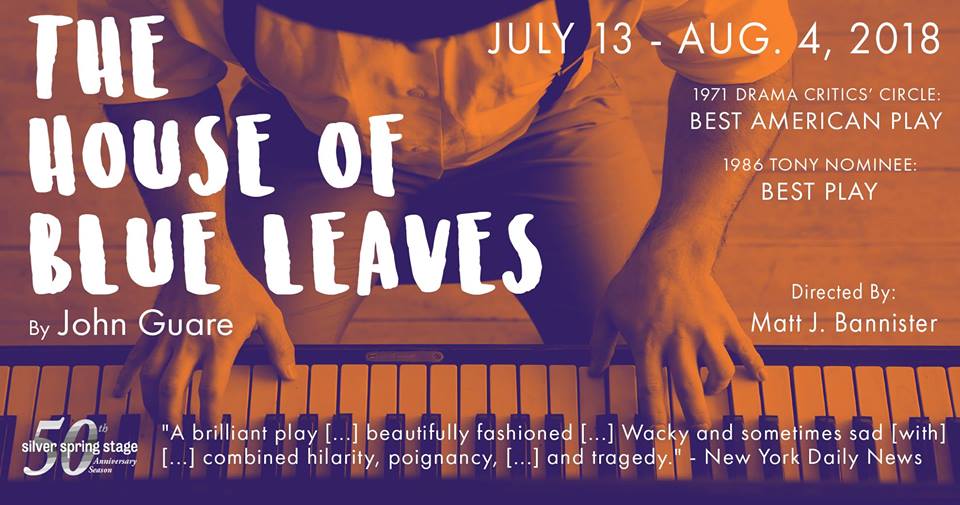It’s 1965 and your music career hasn’t quite turned out the way you thought, the pope’s come to town, your freshly drafted son has gone AWOL, your mistress is trying to drag you down to the street side to see his holiness, and your wife has gone bananas, or rather is Bananas. And then the nuns arrive. It sounds like a zany barrel of laughs, but there’s a much deeper and unsettling darkness happening inside the walls of Artie Shaughnessy’s apartment in Sunnyside, Queens in New York City. The House of Blue Leaves is a disturbingly brilliant, dark dramedy that intensely probes the mind of the audience with its examination of mental illness and the way it impacts the human condition. Directed by Matt J. Bannister and now appearing at Silver Spring Stage to close the main-stage portion of their 50th anniversary season, this evocative and thought-provoking play will twist your mind right round through to its shocking conclusion.
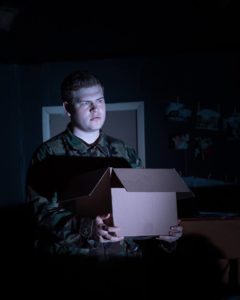
Roomy chaos is the prevailing descriptor of Artie Shaughnessy’s apartment. Set Designer Leigh K. Rawls has once again mastered the unique layout of Silver Spring Stages’ challenging space and created an authentic living space that is perfectly situated in the realm of 1965 (modern day Corn Flakes Box notwithstanding, though props to Properties Master & Designer Erin Schwartz for finding as plain a box as possible to keep congruency across the set.) Rawls creates a ‘lived-in’ space that is cluttered but not messy, lived-in but not distracting. Lighting Designer James Robertson augments the authenticity of the space with natural lighting work, but it’s the soliloquy—aside light cues that sets Robertson’s work apart from the ordinary.
Working with Director Matt J. Bannister’s overall vision of the show, which is a semi-modernization of the way the character asides— written in direct address to the audience in a complete dissolve of the fourth wall— are handled, the light work of James Robertson is best displayed in the television. Whenever a character has a momentary aside, the action on stage freezes, the dim blue glow of a television arises— seemingly from inside the box-tube set and accompanied by Sound Designer Jeff Goldgeier’s subtle snow-static sound effects— and casts an eerie shadowy hue upon the actor’s face. This is a two-fold representation of modernity and the desperate need for fame. Each of the characters in their own right seeks fame of some variety; expressing their inner-monologue confessions to a television screen creates the illusion that they have found an audience. It’s also slightly reminiscent of the Big Brother confession box, a further nod to making modern connectivity in Bannister’s approach to the drama.
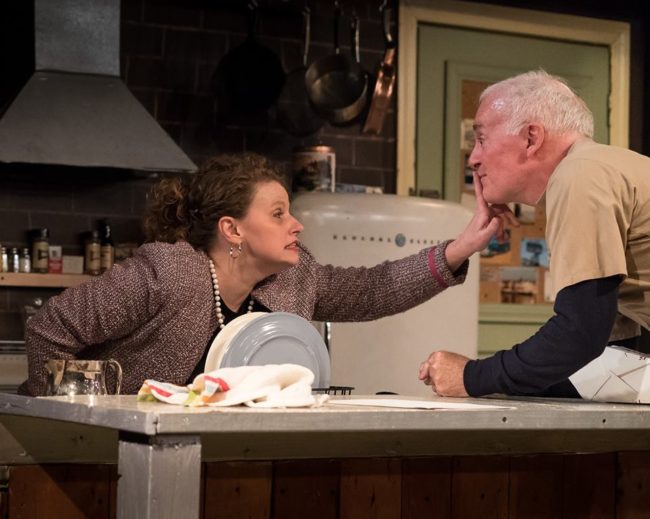
Bannister’s decision to eliminate the fourth-wall direct address best serves the dark nature of the show. Because mental illness and sexism are viewed through far different lenses now in the 21st century than they were when the show was originally written, the overall tone of the show does not align with the disruption such a fourth-wall break would cause. By taking this chance and visionary approach to the script, Bannister realigns the character’s inner desires and internal expressions to those with which a modern audience can more readily relate. Bannister also runs an extremely tight ship, packing the entirety of the show into exactly two hours including the intermission. There is a fine balance which Bannister strikes in his work, keeping the chaos and humors that do arise throughout the show racing forward at a breakneck pace so that when the asides occur, they feel like moments suspended in time— the way a flashback or dream sequence might.
The ultimate success in Bannister’s refocusing on the script’s overall tone is found in his casting choices. Using an authentic high school student to play the son is one such choice that enhances the verisimilitude of the experience. Anson Berns, playing the bombastic Ronnie Shaughnessy, doesn’t truly appear until the second act, save for some cameo quick-glimpses in the first. Berns, who perfectly masters the explosive anger of such a frustrated youth, is congenial in his frustration and fury, well-delivering all of his rage-charged text— much of which occurs in a blue-lit aside— with full potency. It is, at times, difficult to catch all of Berns words because when the character delves into the silent fury of whispering, Berns too lowers his voice to an actual whisper rather than a stage whisper, but this is readily forgiven by his overall erupting nature when it comes to louder moments in the script.
Three nuns— Head Nun (Christine Grable) Second Nun (Pamela Northrup) and Little Nun (Jenny Oberholtzer)— are a great source of comic relief in this darkened drama, with Grable leading the pack in their laughable antics. All three nuns have little quirks, particularly when it comes to body language, but the most notable is Oberholtzer, who lingers a while after some truly explosive things happen. Oberholtzer has animated facial expressions that really earn some laughs before she breaks the habit and settles into the melancholy of the show’s ending. Her direct address to the blue-lit television is one of simplistic hope, a much needed reprieve to that of everyone else’s confessions.
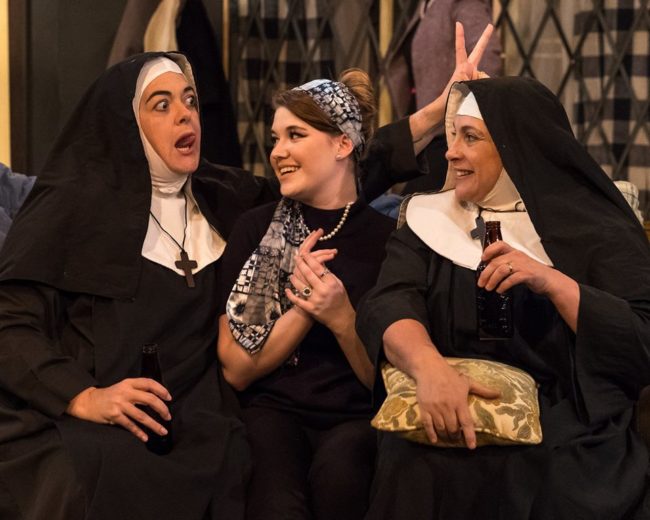
Ron Ward takes up the role of Billy Einhorn, who is only mentioned in the first act, arriving in the second act every bit as built up into the stereotype as the character descriptors of the first act made him out to be. Ward, however, does not create a caricature of this Hollywood producer. Surprisingly enough, that appears to be the connecting through-line for all of the actors in the production, toeing the fine line between character and caricature when so many of these roles are written with the trappings that lend themselves to over-the-top caricatures. The cast, Ward included, finds a frightening honesty in their constructions of these characters, making them exist as people with whom the audience can readily identify. The same through-line exists for Brynn Krasney’s protrayal of Corrinna Stroller. Earnest and sweet, Krasney tackles the secretly defective Hollywood starlet with a gentle honesty, though her facial responses once things go awry for her segment of the story are truly to die for.
While Artie Shaughnessy (Gary Sullivan) is the story’s lead protagonist, the life and times of Artie is defined by the women who are intertwined in his existence. Sullivan holds his own on stage against the astonishingly talented women playing Bunny and Bananas. His piano playing skills and quirky singing ability is on par with the character, portraying a struggling musical composer and lyricist desperate to make his work known and stake his claim to fame. The character itself appears to be written with an aloof coldness and severe distaste, in particular for the Bananas character, but Sullivan’s portrayal lends itself more to the confused and uncertain side of Artie. There is feelings of confliction rather than just contempt, when it comes to Artie’s feelings for Bananas, and this makes him a far more interesting protagonist than the script would suggest. Sullivan should also be praised for his candid ability to carry on a phone conversation where the audience never hears the other side (Billy Einhorn still in California at that point in the script.) There is a lively spark to all he says in that conversation, and the overall delivery is well-paced, making it a believable phone call.
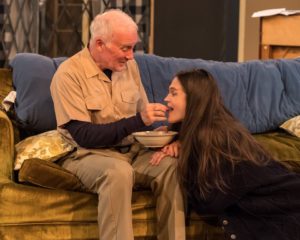
Bunny (Annette Kalicki) and Bananas (Maura Suilebhan) are spinning circles around one another for who holds the title of best in show. It’s a dead-heat tie as both Kalicki and Suilebhan are fully invested in the character they have created; both characters are completely opposite of one another, and both actresses make extraordinary choices, deliver exemplary stage presences, and ultimately create phenomenal performances that are well worth seeing in the show, even if at times the more detrimental and tragic nature of their existences is hard to swallow.
Suilebhan has mastered the physicality of her character Bananas; she looks vacant and frightened, her body stiff and uncertain. Bananas is a mentally ill character, and although the specific mental illness is never addressed, there are aspects of Suilebhan’s portrayal that allow the audience to infer a multitude of conditions that may be afflicting her. The way her vocal delivery arrives in scattered starts is strikingly accurate; Suilebhan delivers harrowing moments of riveting emotion that shake the audience, drawing tears and unease all across the board. Remarkable in every sense of the word, Suilebhan carries the unbearable emotional gravitas of the play with rigor and pride.
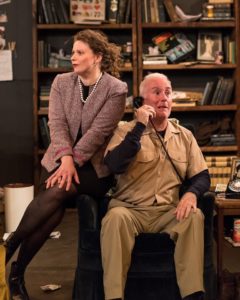
Kalicki carries the other half of the show— as Bannister has transformed The House of Blue Leaves into this yin and yang of comedy and drama— with all of the lighthearted tomfoolery expected of a 1960’s comedy. Sublime in her ability to hilariously chew background scenery (literally— watch her crunch-munch the cornflakes while semi-hidden behind the kitchen counter early in the first act and try not to laugh; you’ll fail), Kalicki has a vivacity beyond compare in this role. Creating the perfect foil to Suilebhan’s Bananas, Kalicki’s Bunny is a refreshing comedic spring which drenches Suilebhan’s dreary and heartbreaking emotional desert of an existence. The pair, though given limited direct interaction, are extraordinary together and are the driving forces of chaos that propel the show forward to its dramatically disturbing conclusion.
The House of Blue Leaves explores a great many things, and Director Matt J. Bannister has succeeded in his attempt to darken the center, blur the edges, and draw its relevance directly to modern audiences. An intense ending to Silver Spring Stage’s 50th season, this show is highly recommended.
Running Time: 2 hours with one intermission
The House of Blue Leaves plays through August 4, 2018 with Silver Spring Stage, located in the Woodmoor Shopping Center— 10145 Colesville Road in Silver Spring, MD. For tickets call the box office at 301-593-6036 or purchase them online.

